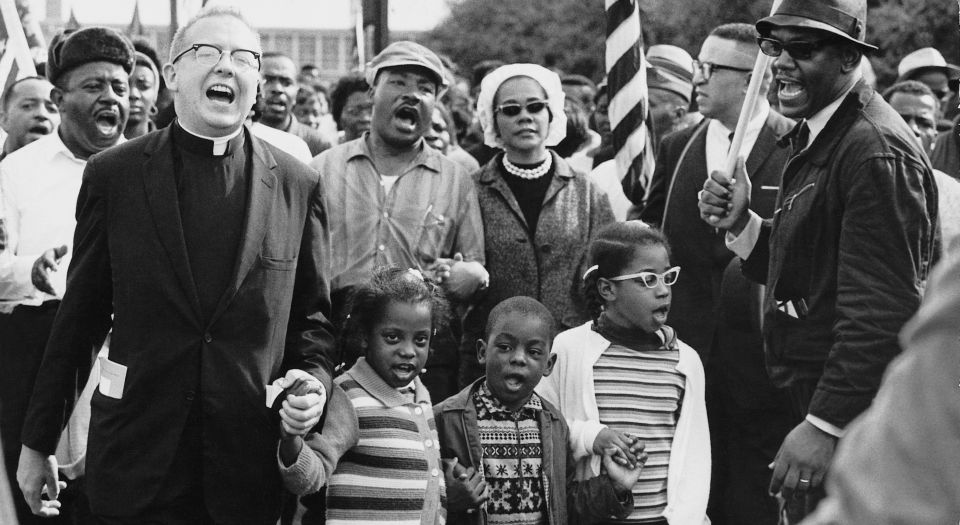Selma 50 years on: why King’s dream still matters
Today’s new racialists are judging people on the colour of their skin.

Today marks 50 years since the 1965 civil-rights marches from Selma to Montgomery, Alabama, were completed. The marchers did not let beatings and tear gas from state troopers, murders of their fellow activists, and opposition from the Alabama governor stop them. Their defiant efforts led, in August that year, to the passing of the Voting Rights Act, a landmark achievement for the movement.
On 25 March, on the steps of the state capitol in Montgomery, Martin Luther King gave a speech that has become known as his ‘How long, not long’ speech. In this powerful and moving address, King presented his hope for the future: ‘We must come to see that the end we seek is a society at peace with itself, a society that can live with its conscience. And that will be a day not of the white man, not of the black man. That will be the day of man as man.’
Fifty years on, we all pay homage to King and the civil-rights activists of Selma and Montgomery. But many who invoke King’s name promote ideas that are diametrically opposed to the universalist philosophy that informed King’s work, and for which he and others gave their lives. We are witnessing today a renewed emphasis on racial thinking and social distinctions – the racialisation of society – which is exactly what the civil rights movement sought to transcend. In the name of being ‘race sensitive’, ‘protecting people of colour’ or raising awareness of ‘white privilege’, the new politically correct racialists are actually destroying King’s dream.
The motivating beliefs of the civil rights movement of the 1960s are far more positive and humanistic than what is being advocated today. Consider the following contrasts between then and now.
1) From overcoming race to promoting racial thinking and division
‘I have a dream that my four little children will one day live in a nation where they will not be judged by the colour of their skin, but by the content of their character.’ This is perhaps Martin Luther King’s most famous line, from his ‘I have a dream’ speech on the steps of the Lincoln Memorial in 1963. And it was not just a view held by King himself; his words summed up the movement’s aim to surmount racial differences. A common sign held up at civil-rights protests read ‘I am a man’ – a straightforward demand to be treated the same as others in society.
Fast forward to today, and we are all encouraged to think about race, all the time. Coinciding with the Selma anniversary, Starbucks launched its initiative to have its baristas write ‘Race Together’ on coffee cups and encourage conversations about race with customers. It was widely mocked (one tweeted that he’ll have a Malcolm Xpresso). Few, however, noted the irony of a ‘let’s all talk about race’ campaign at the very moment we were meant to be commemorating a movement that was opposed to dividing us up into races. Starbucks CEO Howard Schultz believes we need to have a ‘conversation’ about race, but where has he been? The US has spent the past year discussing race constantly, from Ferguson to Oklahoma frat boys singing an n-word song.
And it is not just that more people are viewing society, and talking about it, in racial terms; new race activists are actively promoting separation on the basis of race. In December, white students at the University of Missouri were told they were not welcome at a Ferguson ‘die-in’ protest. A protest leader read out a ‘white privilege’ checklist, citing whites’ putative advantages. Similarly, Ferguson-related protest organisers told ‘white folks’ at the University of Massachusetts that they should not make the ‘hands up’ gesture, to avoid ‘centering’ themselves in a narrative that was not theirs to tell. This compares unfavorably with the civil rights movement, where white people were generally welcomed and played a leading role.
In late February, the principal of a high school in a Chicago suburb held an assembly for black students only, to discuss ‘black lives matter’. Half a century after the civil rights movement tore down segregation in the South, we’re seeing conscious segregation being gradually re-constructed.
2) From the denial of civil rights to ‘microaggressions’
The civil-rights activists were up against state-sanctioned discrimination, as well as widespread prejudice in society. Discrimination was backed by laws (for example, laws that permitted segregation in schooling, such as those struck down by the Supreme Court in Brown vs Board of Education 1954), and enforced by the authorities. Black people were denied equal voting, housing rights and other rights. In response to their campaigns, they faced violence from both the state and racist citizens.
Today, racism is more likely to be discussed in terms of an individual’s thoughts, as a state of mind, rather than as an issue of social and economic structures. It is less a top-down denial of rights by the state or other institutions, than it is a failure by people to speak and behave in a prescribed manner. Racism, it is argued, has moved from overt hatred to ‘microaggressions’ – unintended, insensitive remarks. Claims of microaggressions are especially rampant on campus. In a 2013 case at the University of California at Los Angeles, post-graduate students accused a professor of racial microaggressions for correcting grammar in their term papers, among other slights; the professor was fired. In this world, any distinction between a true act of racism and a faux pas is lost. While yesterday’s civil-rights campaigners confronted police and were denied the vote (real macroaggressions), today’s activists are wounded by offending words or glances.
3) From struggling for equality to therapy and etiquette
In her perceptive book Race Experts, Elisabeth Lasch-Quinn identified the trend of positioning race as an issue of therapy and etiquette, rather than justice or equality. She noted that diversity training in business, multicultural education in schools, and other therapeutic interventions were pushing society towards new codes of conduct. This was a far cry from the marches and mobilisations of the 1960s; indeed, Lasch-Quinn says the new experts ‘hijacked’ the civil-rights revolution.
Lasch-Quinn’s book was published in 2001, and this trend since then has only become more ingrained. Many of New York’s elite private schools now engage in ‘white privilege’ training sessions. Wealthy white students are taught that their freedom from worrying about microaggressions is a privilege in and of itself. An often-used textbook cites flesh-coloured band-aids that match their skin tone as one of the many perks of whiteness. Students are discouraged from discussing their expensive vacations around poorer students of colour. In ‘white privilege’ training, whites who do not confess their racism are deemed ‘in denial’.
These ‘white privilege’ training sessions have more in common with therapy than education. They encourage students to see the world in racial terms, force students into identity boxes and create heightened sensitivities around race. In New York’s private schools, white students learn that they are richer and better off than the average black student across the city – which must come as a shock. As John McWhorter says, students are meant to learn that ‘Living While White constitutes a form of racism in itself’. But, as he points out, it is hard to see what liberal guilt does to improve the lives of black people.
It is safe to say that the civil-rights leaders of the past would have found all of this foreign. King and the other National Association for the Advancement of Colored People (NAACP) leaders were known to oppose any emphasis on racial identity, which they believed threatened the focus on social and economic goals. But, as Lasch-Quinn notes, you could say the new racial etiquette is actually reminiscent of old South. ‘The unspoken, invisible list of sensitivities that all enlightened whites are expected to master’, she writes, ‘evokes the same kind of racially differentiated codes that suffused the segregation era, even while it turns them on its head’.
4) From targeting the authorities to blaming the masses
In its struggle to change laws and policies, the civil rights movement challenged politicians and others in authority. Despite attacks from the Ku Klux Klan and other white citizens, the movement did not drift from its focus on challenging the powers-that-be. This emphasis on the top-down leadership contrasts with today’s prevalent view that the real problem lies with the entrenched bigotry of middle America.
The day after the death of Michael Brown, department of justice (DOJ) officials arrived in Ferguson. The DOJ then organised meetings on ‘white privilege’ among residents. Federal officials talked about underlying prejudice that whites may not perceive, and broke the attendees into small groups to discuss topics like ‘How does white privilege impact race relations in our community?’. Imagine that: there is a police shooting, and the federal government’s first reaction is that the local white people must be made aware of their racism. It is not surprising that the meetings, which were ‘designed to ease tension’, led to people becoming ‘angry and screaming’.
The nationwide protests following the Ferguson incident also betrayed a tendency on the part of anti-racist campaigners to aim their sharpest criticisms at everyday white people. So-called #blackbrunch demonstrators have disrupted brunch meals, which they consider ‘white spaces’, and harangue diners with tales of police brutality. In November, protesters shut down a freeway in San Diego during morning rush hour, which pissed-off commuters trying to get to work. Shouting ‘hands up, don’t shop’, protesters in Minneapolis and elsewhere went to Wal-Mart on ‘Black Friday’ to condemn workers for both racism and buying goods.
5) From the optimism of America’s promise to the pessimism of ‘white supremacy’
Finally, the civil-rights movement was optimistic about the possibility of progress. This optimism is lacking from today’s race advocates. Despite the horrors of slavery and Jim Crow in the years since independence, King and the movement looked to the promise of universal rights held out by American democracy, as established by its Enlightenment-inspired founders. ‘When the architects of our republic wrote the magnificent words of the Constitution and the Declaration of Independence’, said King at the Lincoln Memorial, ‘they were signing a promissory note to which every American was to fall heir. This note was a promise that all men, yes, black men as well as white men, would be guaranteed the “unalienable rights” of “life, liberty and the pursuit of happiness”.’
In contrast, today’s promoters of racial difference view America as inherently and irredeemably racist. To them, American history is one long, neverending story of ‘white supremacy’, and the only thing worth knowing about the founders is that they owned slaves. In their eyes, the anniversary of Selma is an occasion to highlight how little things have since changed. But, in doing so, the race advocates minimise the tremendous accomplishments of the civil-rights movement in knocking down legal and social barriers, and express a deep pessimism about the future. Indeed, their whole message is about assigning people to rigid racial categories, which has the effect of increasing divisions in society and making things worse.
The new racialists might claim to be the inheritors of the civil-rights tradition, but the truth is they are imposters. They will denounce anyone who dares to espouse King’s vision of a colour-blind world of real equality, and anyone who believes that people should be judged by the ‘content of their character’. It is they who are ‘in denial’ – in denial that they represent everything the civil-rights movement fought against, in denial that they are its gravediggers.
Those who wish to live up to the ideals of the civil rights movement, and honour the courage of its heroes, can start by challenging the new racialism and revitalising the case for universalism and freedom for all.
Sean Collins is a writer based in New York. Visit his blog, The American Situation.
Picture by: Abernathy Family/Wikimedia Commons
To enquire about republishing spiked’s content, a right to reply or to request a correction, please contact the managing editor, Viv Regan.








Comments
Want to join the conversation?
Only spiked supporters and patrons, who donate regularly to us, can comment on our articles.